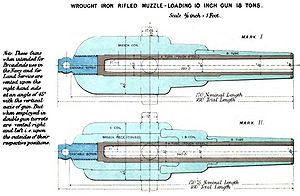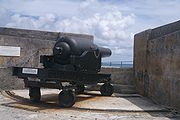
RML 10 inch 18 ton gun
Encyclopedia
The RML 10 inch guns Mk I - Mk II were large rifled muzzle-loading guns designed for British battleships and monitors. They were also fitted to the Bouncer-class flat-iron gunboat
s.
 The 10-inch gun was a standard "Woolwich
The 10-inch gun was a standard "Woolwich
" design (characterised by having a steel A tube with relatively few broad, rounded and shallow rifling grooves) developed in 1868, based on the successful Mk III 9-inch gun
, itself based on the "Fraser" system. The Fraser system was an economy measure applied to the successful Armstrong
design for heavy muzzle-loaders, which were expensive to produce. It retained the Armstrong steel barrel surrounded by wrought-iron coils under tension, but replaced the multiple thin wrought-iron coils shrunk around it by a single larger coil (10 inch Mark I) or 2 coils (Mark II); the trunnion ring was now welded to other coils; and it eliminated Armstrong's expensive forged breech-piece.
The gun was rifled with 7 grooves, increasing from 1 turn in 100 calibres to 1 in 40.
It was first used for the main armament on the central battery ironclad HMS Hercules
, completed in late 1868.
A number of the Mk I guns on HMS Hercules and one of the two damaged guns in HMVS Cerberus suffered from cracked barrels. Presumably this is why only a few (at least 24) Mk I guns were made.
The gun's primary projectile was "Palliser" shot or shell
, an early armour-piercing projectile for attacking armoured warships. A large "battering charge" of 70 pounds "P" (pebble) or 60 pounds "R.L.G." (rifle large grain) gunpowder was used for the Palliser projectile to achieve maximum velocity and hence penetrating capability.
Common (i.e. ordinary explosive) shells and shrapnel shells were fired with the standard "full service charge" of 44 pounds "P" or 40 pounds R.L.G. gunpowder, as for these velocity was not as important.

One 10 inch Mk I Common Shell, one Mk II Common Shell, one Mk II or Mk III Common Shell & one 10 inch Mk III Palliser Shot as part of the Victorian Navy display at the Geelong Maritime Museum, Australia. Details
Flat-iron gunboat
Flat-iron gunboats were a number of classes of coastal gunboats generally characterised by small size, low freeboard and the absence of masts.Some Rendel-type gunboats were fitted with masts ; they are included in the article for...
s.
Design

Royal Arsenal
The Royal Arsenal, Woolwich, originally known as the Woolwich Warren, carried out armaments manufacture, ammunition proofing and explosives research for the British armed forces. It was sited on the south bank of the River Thames in Woolwich in south-east London, England.-Early history:The Warren...
" design (characterised by having a steel A tube with relatively few broad, rounded and shallow rifling grooves) developed in 1868, based on the successful Mk III 9-inch gun
RML 9 inch 12 ton gun
The RML 9 inch guns Mark I - Mark VI were large rifled muzzle-loading guns used as primary armament on smaller British ironclad battleships and secondary armament on larger battleships, and also ashore for coast defence.-Design:...
, itself based on the "Fraser" system. The Fraser system was an economy measure applied to the successful Armstrong
William George Armstrong, 1st Baron Armstrong
William George Armstrong, 1st Baron Armstrong CB, FRS was an effective Tyneside industrialist who founded the Armstrong Whitworth manufacturing empire.-Early life:...
design for heavy muzzle-loaders, which were expensive to produce. It retained the Armstrong steel barrel surrounded by wrought-iron coils under tension, but replaced the multiple thin wrought-iron coils shrunk around it by a single larger coil (10 inch Mark I) or 2 coils (Mark II); the trunnion ring was now welded to other coils; and it eliminated Armstrong's expensive forged breech-piece.
The gun was rifled with 7 grooves, increasing from 1 turn in 100 calibres to 1 in 40.
It was first used for the main armament on the central battery ironclad HMS Hercules
HMS Hercules (1868)
HMS Hercules was a central-battery ironclad of the Royal Navy in the Victorian era, and was the first warship to mount a main armament of calibre guns....
, completed in late 1868.
A number of the Mk I guns on HMS Hercules and one of the two damaged guns in HMVS Cerberus suffered from cracked barrels. Presumably this is why only a few (at least 24) Mk I guns were made.
Ammunition
When the gun was first introduced in 1868, projectiles had several rows of projecting "studs" which engaged with the gun's rifling to impart spin. From the mid-late 1870s, spin was imparted by "gas checks" connected to the base of the projectile which engaged the rifling grooves, making studs unnecessary, and hence the shells were designated "studless".The gun's primary projectile was "Palliser" shot or shell
Palliser shot
Palliser shot was invented by Sir William Palliser and hence its name. It was an early British armour-piercing artillery projectile, intended to pierce the armour protection of warships being developed in the second half of the 19th century.-History:...
, an early armour-piercing projectile for attacking armoured warships. A large "battering charge" of 70 pounds "P" (pebble) or 60 pounds "R.L.G." (rifle large grain) gunpowder was used for the Palliser projectile to achieve maximum velocity and hence penetrating capability.
Common (i.e. ordinary explosive) shells and shrapnel shells were fired with the standard "full service charge" of 44 pounds "P" or 40 pounds R.L.G. gunpowder, as for these velocity was not as important.
Surviving examples

- 4 guns submerged near the remains of HMVS CerberusHMVS CerberusHMVS Cerberus is a breastwork monitor that served in the Victoria Naval Forces, the Commonwealth Naval Forces , and the Royal Australian Navy between 1871 and 1924....
in Half Moon Bay, VictoriaHalf Moon Bay, VictoriaHalf Moon Bay is a bay and neighbourhood on Port Phillip, south east of Melbourne. Located in the suburb of Black Rock, it is home to the Black Rock Yacht Club. This bay also gets a mention in the Cat Empire song, "The Wine Song". Half Moon Bay is also home to HMVS Cerberus, the last surviving...
, Australia (3 x Mk I & 1 x Mk II) - Damaged Mk I gun No. 17 from HMVS Cerberus is on display at HMAS Cerberus Victoria, Australia
- Mk II gun No. 67 at Southport Gates, GibraltarGibraltarGibraltar is a British overseas territory located on the southern end of the Iberian Peninsula at the entrance of the Mediterranean. A peninsula with an area of , it has a northern border with Andalusia, Spain. The Rock of Gibraltar is the major landmark of the region...
- A Mk II gun at Parsons Lodge Battery, Gibraltar
- Mk II No. 273 at Almeda Gardens, Gibraltar
- Mk II guns Several guns at Fort St Catherine, St George's Island, Bermuda (at least three are Mk II guns)
- A Mk II at the Citadel, Quebec City, Canada
One 10 inch Mk I Common Shell, one Mk II Common Shell, one Mk II or Mk III Common Shell & one 10 inch Mk III Palliser Shot as part of the Victorian Navy display at the Geelong Maritime Museum, Australia. Details
External links
- Diagram of gun on Casemate Traversing Platform, at Palmerston Forts Society website
- Diagram of gun on Dwarf "D" Pivot mounting, at Palmerston Forts Society website
- Diagram of gun on 7 foot Parapet "C" mounting, at Palmerston Forts Society website
- Diagram of gun on 7 foot Parapet "C" Long Range mounting, at Palmerston Forts Society website

